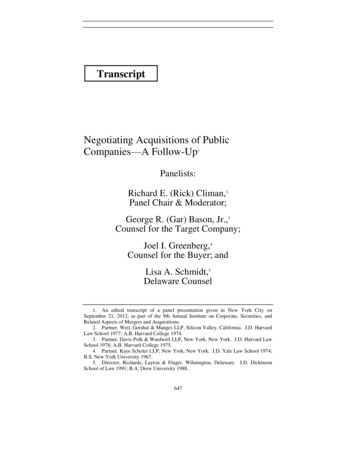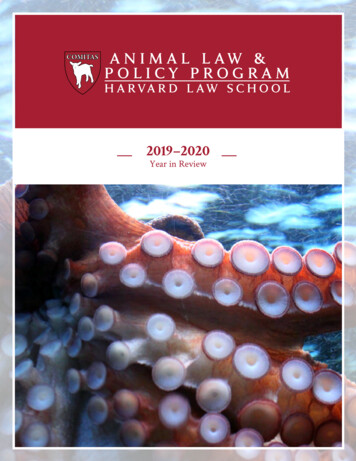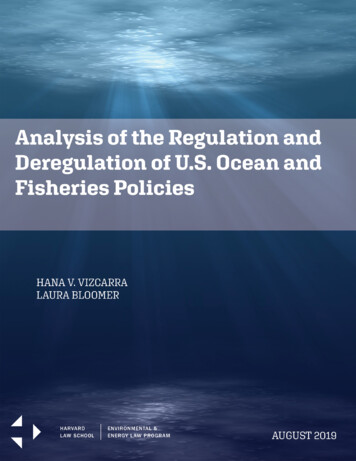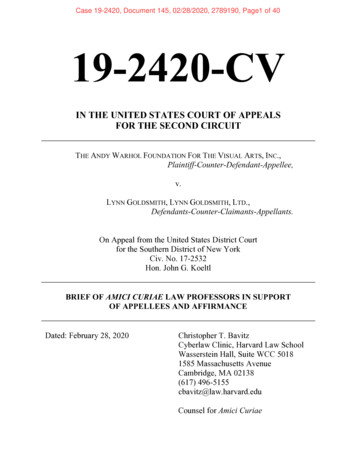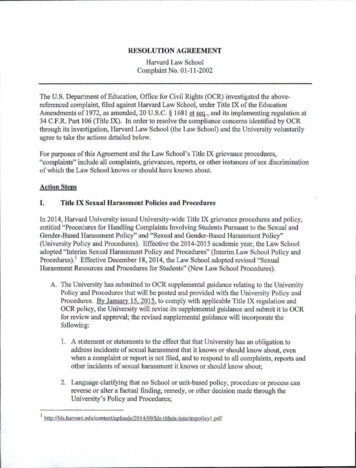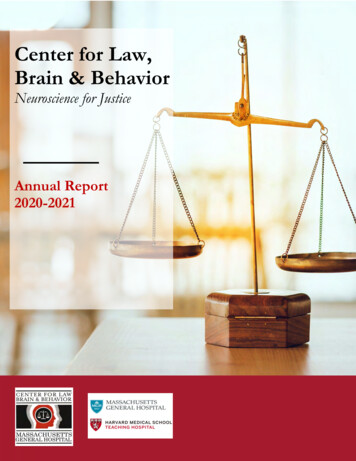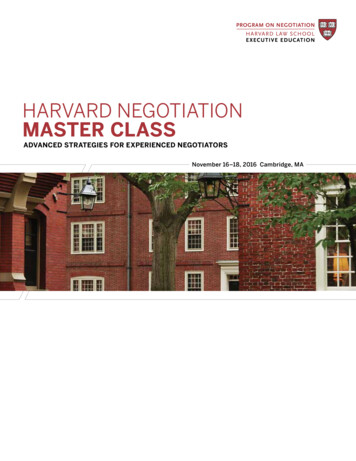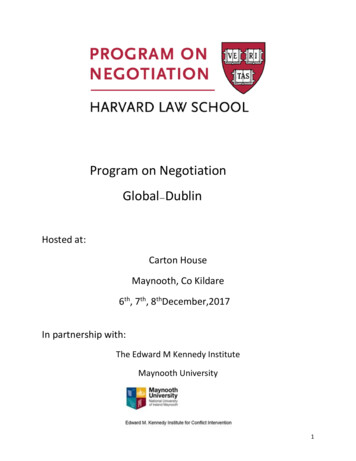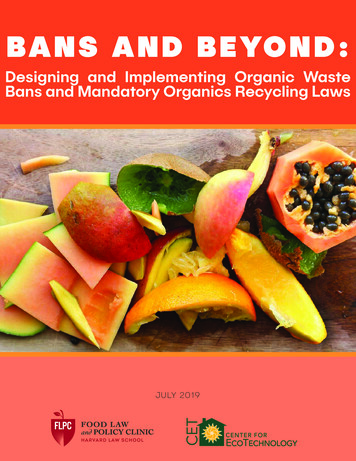
Transcription
BANS AND BEYOND:Designing and Implementing Organic WasteBans and Mandatory Organics Recycling LawsJU LY 2 0 19
AuthorsThe lead authors of the report are Katie Sandson and Emily Broad Leib, Harvard Law School Food Law andPolicy Clinic, with input from Lorenzo Macaluso and Coryanne Mansell, Center for EcoTechnology.Portions of the report are based on research and writing by the following Food Law and Policy Clinic studentsand summer interns: Brittany Bolden, Duan Duan, Solange Etessami, Amy Hoover, Nathaniel Levy, SarahLoucks, Darya Minovi, Mary Stottele, and Jack Zietman.AcknowledgmentsThis report would not have been possible without the advice and support of the many individuals with whomwe discussed the ideas provided herein, including Sue AnderBois, Christine Beling, Ana Carvalho, DaveDidonato, Alex Dmitriew, Jennifer Erickson, Nic Esposito, Gary Feinland, John Fischer, Nora Goldstein, TerryGray, Barbara Hamilton, Cathy Jamieson, Carol Jones, Josh Kelly, Jesse Kerns, Fredrik Khayati, GenaMcKinley, Manuel Medrano, Nick Lapis, Chris Nelson, Krystal Noiseux, Kyle Pogue, Melissa Romero, SallyRowland, Meghan Stasz, Holly Stirnkorb, Jenny Trent, Nick Van Eyck, Jennifer Winfrey, Ashley Zanolli. Theseindividuals provided their time and insights, and may or may not agree with the full findings reported in thetoolkit.About the Harvard Law School Food Law and Policy ClinicThe Harvard Law School Food Law and Policy Clinic (FLPC) serves partner organizations and communities byproviding guidance on cutting-edge food system issues, while engaging law students in the practice of foodlaw and policy. Specifically, FLPC focuses on increasing access to healthy foods, supporting sustainableproduction and regional food systems, and reducing waste of healthy, wholesome food. For more information,visit http://www.chlpi.org/flpc/.About the Center for EcoTechnologyThe Center for EcoTechnology helps people and businesses save energy and reduce waste. Our innovativenon-profit works with partners throughout the country to address climate change by transforming the waywe live and work - for a better community, economy, and environment. For over two decades, the Center forEcoTechnology has been an award-winning leader and pioneer in developing and implementing sustainablesolutions to the problem of wasted food. For more information, visit wastedfood.cetonline.org/.Made Possible with Support from the Claneil Foundation and Walmart FoundationThe research included in this report was made possible through funding by the Claneil Foundation andWalmart Foundation. The findings, conclusions, and recommendations presented in this report are those ofthe Harvard Law School Food Law and Policy Clinic alone, and do not necessarily reflect the opinions of theClaneil Foundation or the Walmart Foundation.
Introduction.1I.Organic Waste Bans: The Legal Landscape.3A. State Waste Bans.4B. Municipal Waste Bans.9C. Zero Waste Plans and Other Food Waste Management Strategies.14II. Costs and Benefits of Organic Waste Bans.16A. Case Analyses.17B. Implications of Costs and Benefits to Stakeholders.20III. Designing Organic Waste Bans and Mandatory Organics Recycling Laws.24A. To Ban or Not to Ban.24B. Considerations for Structuring and Enacting an Organic Waste Ban.25IV. Barriers, Challenges & Solutions.32A. Political considerations.32B. Funding.34C. Infrastructure.36D. Enforcement Logistics.38E. Contamination.40V. Beyond the Ban — Policies and Programs That Can Impact Waste Bans and WasteReduction.42A. Grants for Food Waste Reduction and Diversion.42B. Food Rescue Infrastructure.45C. Hauling Arrangements.46D. Renewable Portfolio Standards.47E. Creating Markets for Compost End-Products.48F. Zoning.48G. Permitting for Composting and AD Facilities.49H. Tipping Fees.50I. Pay As You Throw.52J. Flow Control and Gas Capture Contracts.53VI. Technical Assistance and Public Awareness.57A. Technical Assistance for Food Waste Generators and Service Providers.57B. Public Outreach and Education.60
INTRODUCTIONApproximately forty percent of food in the United States goes uneaten.1 Wasted food significantly impacts theenvironment, the economy, and food insecurity. Approximately twenty-one percent of the United States’ freshwater supply2 and 300 million barrels of oil are used to produce food that goes to waste.3 Most of this wastedfood ends up in landfills, and food is the largest individual component of municipal solid waste in landfills.4 In2012, more than twenty percent of municipal solid waste disposed of was food waste.5 Reliance on landfillsas a central part of waste management systems presents challenges. Cities and states are running out ofspace to pile trash.6 Furthermore, organic materials in landfills decompose and release methane, a powerfulgreenhouse gas that contributes to climate change.7 Food waste is responsible for at least eleven percentof methane emissions generated from landfills, an amount equivalent to the emissions of about 3.4 millionvehicles.8In recent years, food waste has attracted increasing amounts of attention from food system and environmentaladvocates, government officials, and the general public. As awareness of this problem has grown, federal,state, and local governments have explored opportunities to implement policies that will reduce and divertfood waste. Organic waste bans are emerging as a new and effective policy tool to address this issue at thestate and local level. In this toolkit, the term “organic waste ban” is defined broadly to include all policies thatrestrict the amount of food waste or organic waste that food businesses or individuals can dispose of, as wellas policies that require diversion of food waste or subscription to a collection service to send food scrapsto a composting or anaerobic digestion (AD) facility. This toolkit specifically addresses organic waste bansthat have a food waste component; it does not address bans or policies that apply only to yard waste. Byplacing restrictions on food waste disposal, organic waste bans can drive food waste generators to exploremore sustainable practices, such as food waste prevention, donation, and recycling food waste throughcomposting and AD. In addition to organic waste bans, some states and localities are also seeking to reducefood waste, and waste in general, through other diversion strategies such as zero waste plans and wastemanagement strategies; unlike organic waste bans, these types of plans generally do not themselves createlegally enforceable obligations. Although these strategies will not be discussed in detail in this toolkit, they arean important trend and another tool available to states and localities.This toolkit analyzes the structure and implementation of organic waste bans and presents examples fromstates and cities with existing or proposed waste bans. The toolkit provides a resource to help state and localBans and Beyond: Designing and Implementing Organic Waste Bans and Mandatory Organics Recycling Laws- Page 1 -
governments, advocates, and other stakeholders evaluate options for developing policies to address foodwaste and tailor approaches to state or local context. The toolkit analyzes organic waste bans from a holisticperspective, examining the structure of organic waste ban laws as well as other factors including funding,infrastructure, enforcement, and education. Together, these components can have a significant impact onhow an organic waste ban policy will function in a given state or locality.HOW TO USE THIS TOOLKITThe utility of this toolkit will depend on the current state of organic waste management policies in a givenstate or locality. Some states and localities already have an organic waste ban or mandatory organicsrecycling law in place. Others may be looking to expand on existing zero waste goals or waste managementstrategies, while some may be starting largely from scratch. This toolkit is meant to be accessible to readersand need not be read cover to cover. Readers should feel free to jump to the sections that will be most usefulto them. The toolkit makes frequent use of cross-references in order to refer readers to other sections ofthe toolkit that cover related information. Additionally, the checklists at the end of Sections III and V providesuccinct summaries of the contents of these sections. These checklists are meant to be interactive and canbe used by readers to apply the lessons of this toolkit to their own jurisdictions.This toolkit comprises six sections as outlined below. Each section contains several parts. Section I: Organic Waste Bans: The Legal Landscape: This section provides an overview of state andlocal organic waste bans that have passed as of April 2019. For each policy, this section summarizeswhen it took effect, what kinds of entities are regulated, how those entities can comply, and how thepolicy can be enforced. Section II: Costs and Benefits of Organic Waste Bans: This section analyzes costs and benefitsof organic waste bans, drawing on analyses conducted in Massachusetts and New York, as well asexamples from other states, in order to evaluate the impacts of organic waste bans on stakeholderssuch as food waste generators, haulers, processors, and states and localities. Section III: Designing Organic Waste Bans and Mandatory Organics Recycling Laws: Each stateor municipality that develops an organic waste ban must make decisions about how to structureits policy based on its geographic, economic, and cultural characteristics; desired outcomes; andresource constraints. This section outlines decisions that states and municipalities will need to considerwhen designing waste bans. Section IV: Barriers, Challenges, and Solutions: This section discusses common barriers that statesand municipalities may face when designing, enacting, or implementing organic waste bans, includingchallenges with funding, enforcement, and infrastructure development. The section also proposespotential strategies for mitigating these challenges. Section V: Beyond the Ban: There are many other related policies that can impact the efficacy of anorganic waste ban. For states and localities that are unable or choose not to implement an organicwaste ban, the implementation of these policies can help reduce food waste and facilitate diversionin the absence of a ban. This section describes several of these policies and programs, includingpermitting requirements and zoning laws for organics processing facilities, tipping fees, policies tosupport food donation, and grant funding to support food waste reduction, food rescue, and organicsrecycling. Section VI: Technical Assistance and Public Awareness: Providing technical assistance to foodwaste generators, haulers, and processors can play an important role in supporting organic wastebans by increasing awareness of these policies and helping covered entities comply. Increasing publicawareness is also important to facilitate compliance with organic waste bans that cover individualresidents, and to encourage food waste reduction at the household level more broadly. This sectionexplores best practices for providing technical assistance, outreach, and education to food wastegenerators, service providers, and the general public in support of organic waste reduction.Bans and Beyond: Designing and Implementing Organic Waste Bans and Mandatory Organics Recycling Laws- Page 2 -
USETTSRHODE ISLANDCONNECTICUTBoulderFr San anciscoCALIFORNIAAustinI. ORGANIC WASTE BANS: THE LEGAL LANDSCAPEThis section provides an overview of existing waste bans in six states and seven localities. Before discussingthe existing policies, this section will set out several definitions for terms used throughout the report.In this toolkit, the term organic waste ban is a generic term that refers to a category of laws and regulatoryrequirements that restrict the amount of organic waste or food waste that can be disposed of in landfills orrequire organic waste diversion. The toolkit focuses in greater detail on two types of waste bans. Disposal bans prohibit covered entities from sending organic waste or food waste to the landfill butdo not specify what covered entities must do with that waste. Mandatory organics recycling laws typically require covered entities to take a particular action,such as subscribing to an organics collection service or sending food waste to a composting oranaerobic digestion (AD) facility.Individual states and cities may also use other terms to describe their own policies, such as landfill bans, foodscrap bans, and universal recycling ordinances.This toolkit uses the terms “covered entities,” “waste generators,” and “regulated entities” interchangeably torefer to the entities, such as businesses, institutions, or residences, that are subject to the requirements of anorganic waste ban.Part A of this section provides an overview of the six existing state organic waste bans and mandatoryrecycling laws. A table that summarizes the main features of each state law is set forth at the end of PartA. Part B of this section provides an overview of the seven municipal organic waste bans and mandatoryrecycling laws, and a table summarizing these laws is set forth at the end of Part B. Part C of this sectionprovides a handful of examples of zero waste plans and other non-binding waste management strategiesthat states and cities have used to address food waste.Bans and Beyond: Designing and Implementing Organic Waste Bans and Mandatory Organics Recycling Laws- Page 3 -
A. STATE WASTE BANSCaliforniaOverview: In September 2014, California’s Governor approved the California Mandatory CommercialRecycling Law, AB 1826, which requires certain businesses to subscribe to organic waste recycling services.9The law took effect on January 1, 2015, though it did not impose any legal obligations on covered entities untilApril 1, 2016.10Requirements: Broadly, the law requires businesses11 that produce specified amounts of organic waste12 tocomply with organic waste recycling procedures in order to reduce the amount of organic waste in landfills.Specifically, covered businesses must do at least one of the following: Source-separate13 organic waste and subscribe to an organic waste recycling service;Recycle organic waste onsite or self-haul it to a recycling facility;Sell or donate surplus food; orSubscribe to a mixed-waste recycling service that recycles organic waste.14The law is structured to phase in covered businesses over time based on the amount of waste they produce.Beginning April 1, 2016, the law covered businesses that produce eight or more cubic yards of organic wasteper week.15 Beginning January 1, 2017, the law covered businesses that produce four or more cubic yards oforganic waste per week.16 Beginning on January 1, 2019, the law applied to businesses that produce four ormore cubic yards of all types of commercial solid waste per week.17 If by 2020 the amount of total statewideorganic waste disposed of in landfills is still greater than fifty percent of the 2014 amount, then the law willphase in additional categories of businesses and residences.18Under AB 1826, local jurisdictions are required to implement organic recycling programs to divert organicwaste from covered businesses.19 These programs must identify existing organic recycling facilities within thejurisdiction; provide education and outreach to businesses within the jurisdiction; and monitor businesses andnotify those that are not in compliance with the requirements outlined above.20 The program may, but neednot, include adopting a mandatory organic recycling ordinance at the local level.21 Local jurisdictions mayimplement requirements for businesses that are stricter than the state requirements, and businesses mustcomply with these local requirements.22Local governments in rural jurisdictions–those with a population of 70,000 or fewer–can exempt theirjurisdictions from the requirements of the law by adopting a resolution and submitting it to the CaliforniaDepartment of Resources Recycling and Recovery (CalRecycle) at least six months before the resolutiontakes effect.23 However, if on or after January 1, 2020 CalRecycle determines that the amount of totalstatewide organic waste disposed of in landfills is still greater than fifty percent of the 2014 amount, then ruralexemptions will terminate unless CalRecycle permits them to remain in place.24Enforcement: The law grants local jurisdictions discretion with respect to enforcement. The law permits,but does not require, local governments to establish enforcement mechanisms such as fines.25 Similarly, thestatute permits localities to grant exemptions to otherwise covered entities in certain scenarios, such as whenbusinesses lack sufficient space for additional recycling bins or when businesses are already taking actionsto recycle a significant amount of their organic waste.26Other notable features: AB 1826 is a part of a larger collection of laws and regulations in California thatworks toward reducing the environmental impacts of waste disposal. The first of these laws, AB 341, whichpassed in 2011, set a seventy-five percent recycling goal for the state by 2020.27 Other California laws andregulations have established reporting requirements for counties and regions on organic waste generationBans and Beyond: Designing and Implementing Organic Waste Bans and Mandatory Organics Recycling Laws- Page 4 -
and processing capacity28 and set targets to reduce short-lived climate pollutants, such as methane.29Most recently, AB 1383 established additional targets for reducing organic waste disposal and ordered thedevelopment of regulations requiring twenty percent of edible waste to be recovered for human consumptionby 2025.30 The rulemaking process for AB 1383 was ongoing as of the time of publication.31ConnecticutOverview: Connecticut was the first state to pass a commercial organic waste law. The statute was firstpassed in 2011 and amended in 2012.32 The amended statute took effect on January 1, 2014.33Requirements: Effective January 2014, Connecticut requires covered food waste generators, includingsupermarkets, resorts, conference centers, commercial food wholesalers or distributors, and industrial foodmanufacturers or processors to source-separate and divert their food waste to an authorized organicsprocessing facility with available capacity or treat the food waste on-site.34 To be covered by the law, a foodwaste generator must be projected to generate 104 or more tons of food waste per year and be located withintwenty miles of an authorized organics composting facility.35 In January 2020, the law will expand to coverbusinesses projected to generate fifty-two or more tons of food waste per year.36 Businesses can comply bydonating surplus food, using food scraps for animal feed, processing food scraps on-site, or sending foodscraps to a composting or AD facility, which need not be located in Connecticut.37 Although K-12 schools anduniversities are not covered by the ban, school-owned standalone conference centers are covered.38Enforcement: There are no fines associated with violation of Connecticut’s organic waste ban.39 However, theConnecticut Department of Energy and Environmental Protection (DEEP) can pursue enforcement measurespursuant to the department’s Enforcement Response Policy if a covered generator does not make a goodfaith effort to comply with the law.40MassachusettsOverview: Unlike other states with organic waste bans, Massachusetts established its disposal ban throughregulation rather than legislation. In 2014, the Massachusetts Department of Environmental Protection(MassDEP) amended regulations on solid waste disposal by adding “commercial organic material” to a list ofseveral materials already barred from entering solid waste disposal streams.41 The amended regulations tookeffect on October 1, 2014.42Requirements: Massachusetts defines “commercial organic material” as food and vegetative materialsfrom an entity that is not a residence and that generates for disposal at least one ton of those materials inwaste per week.43 Because this definition specifically excludes material from residences, the ban appliesonly to commercial and institutional food waste generators.44 Waste generators are covered only for weeksduring which they meet the one-ton threshold.45 MassDEP may grant covered waste generators a temporaryexemption from the ban if (a) the waste is contaminated or unacceptable for composting or other use, andthe person responsible takes steps to prevent the contamination from recurring; or (b) if a waste generator’susual composting or other processing service declines the waste and the generator cannot find an alternative“within a reasonable time.”46Food scrap generators may comply by reducing their food scrap production below the one ton per weekthreshold, donating surplus food, processing food scraps onsite, or sending food scraps to an animal feed,composting, or AD facility.47Enforcement: The regulations give MassDEP authority to take enforcement actions against violators of thesolid waste disposal regulations, including the ban on disposal of commercial organic material. If MassDEPBans and Beyond: Designing and Implementing Organic Waste Bans and Mandatory Organics Recycling Laws- Page 5 -
identifies a violation, it has the authority to order violators to comply with the regulations and issue orders ofnon-compliance or administrative penalties.48New YorkOverview: New York State passed a food scraps recycling requirement in April 2019 as part of the Fiscal Year2020 budget process.49 Several versions of an organic waste ban had previously been proposed in recentyears, both through the budget process and through separate legislation.50 The law instructs all designatedfood scraps generators to donate surplus food for human consumption to the extent possible and requirescertain designated food scraps generators to divert remaining food scraps for organics processing.51 Therequirements will take effect January 1, 2022.52Requirements: New York defines designated food scraps generators as those that produce over two tonsper week of food scraps, including entities such as supermarkets, food service establishments, universities,hotels, food processors, correctional facilities, and entertainment venues. 53 Healthcare facilities, such ashospitals and nursing homes, and elementary and secondary schools are excluded from the requirements ofthe law.54 Starting January 1, 2022, New York’s law instructs all designated food scraps generators to donatesurplus edible food for human consumption to the extent possible.55 Additionally, designated food scrapsgenerators located within twenty-five miles of an organics recycler with available capacity will be requiredto separate food scraps and transport them to an organics recycling facility, such as a compost or AD facilityor animal feed operation.56 Food scraps generators may self-haul the material or contract with a service totransport the material.57 Designated food scraps generators may apply for a temporary waiver from theserequirements if they can demonstrate “undue hardship,” including if the cost of recycling organic waste is notcompetitive with the cost of landfill disposal, nearby organics recyclers do not have sufficient capacity, orother unique circumstances apply.58All designated food scraps generators will be required to submit an annual report that includes the amountof food donated and recycled, as well as the organics recyclers and transporters used, beginning March2023.59Enforcement: The New York Department of Environmental Conservation (DEC) is responsible for carrying outthe food donation and food scraps recycling law, although specific enforcement mechanisms and penaltiesare not identified. DEC is required to develop rules and regulations to implement the law, including developingmethodologies for determining which food scrap generators are covered, developing the waiver process,and compiling a list of covered generators, organics recyclers, and organics haulers.60 By June 1, 2021, DECis also required to evaluate the capacity of organics recycling facilities and notify food scrap generatorsabout whether they are required to comply with the law.61Rhode IslandOverview: Rhode Island first passed legislation in June 2014 requiring food waste diversion by certaincommercial and institutional entities.62 The statute was amended in July 2016 to expand coverage toadditional entities.63Requirements: Beginning January 1, 2016, Rhode Island’s law required covered entities to divert organicwaste to an authorized composting or AD facility, or a facility that uses any other authorized recycling method,including on-site treatment and animal feed.64 Covered entities include businesses such as supermarkets,restaurants, resorts, conference centers, food wholesalers or distributors, and food manufacturers orprocessors, as well as institutions such as prisons, healthcare facilities, and certain covered educationalfacilities.65 In order to be covered by the law, a business or institution must (a) generate at least 104 tons ofBans and Beyond: Designing and Implementing Organic Waste Bans and Mandatory Organics Recycling Laws- Page 6 -
organic waste per year, and (b) be located within fifteen miles of an authorized composting or AD facility withcapacity to accept the material.66 As of January 1, 2018, the law applies to covered educational facilities thatgenerate at least fifty-two tons of organic waste per year.67 Individual businesses or institutions may receive awaiver from the Department of Environmental Management (DEM) if the available composting or AD facilitieswithin fifteen miles charge a higher tipping fee than the fee charged for landfill disposal.68Enforcement: The law provides that violators of the organic waste ban, as well as other solid waste disposallaws, may be subject to a civil penalty up to a maximum of 25,000,69 although enforcement has beendeferred until more processing capacity is developed in Rhode Island.70VermontOverview: Vermont’s Universal Recycling Law bans disposal of food scraps in addition to “blue bin” recyclablesand leaf and yard debris.71 The law passed in 2012, and the requirements related to food scrap disposalbegan to take effect on July 1, 2014.72Requirements: The key features of Vermont’s Universal Recycling Law include a phased-in food scrap ban,described in more detail below, as well as: Parallel collection – waste haulers and drop-off centers for trash collection must also offer recyclingand food scrap collection services;73Unit-based pricing – all municipalities must combine costs of recycling and trash into one fee forresidential customers;74 andPublic space recycling – public trash containers must also include recycling receptacles.75The food scrap provisions of the Universal Recycling Law require covered waste generators to sourceseparate their food scraps and send them to facilities that
About the Harvard Law School Food Law and Policy Clinic The Harvard Law School Food Law and Policy Clinic (FLPC) serves partner organizations and communities by providing guidance on cutting-edge
